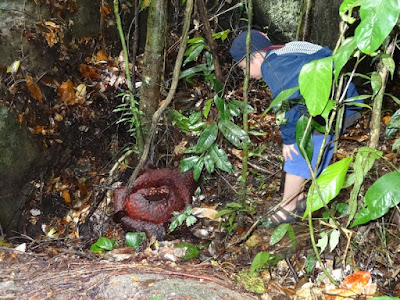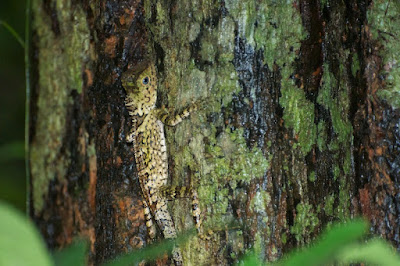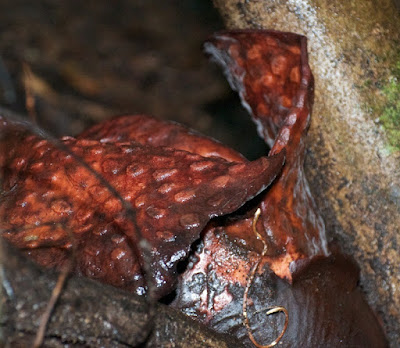Gunung Gading National Park, west of Kuching, is one of the best places to find one of the wonders of Borneo: Rafflesia, the largest flower in the world. I have been there a number of times, but I am always glad to go back. Only a few days after our return to Kuching, on January 19, 2014, Eileen and I, with our grandson Ryan, our friend Daisy and her sister Abi, we set off for Gunung Gading once again, chasing reports that the Rafflesias were, briefly, in flower.
Getting to the flowers required following our guide off trail. Rafflesias parasitize woody vines in the genus Tetrastigma (members of the grape family, Vitaceae) that have the habit of scrambling over rocks, so invading their territory involves, sometimes, a bit of uncertain footing.
There were, of course, things to see on the way. Gunung Gading hosts not only one of the largest flowers in the world, but one of the largest inflorescences. Voodoo lilies (Amorphophallus spp), members of the arum family (Araceae), produce a huge, extremely smelly flowering spike (or spadix) wrapped in a bract, or spathe, that sweeps around its base. I have never seen one in bloom, but this is the remains of a spadix still clustered with fruit. The giant is A. titanum from Sumatra, but A. hewittii, the species at Gunung Gading, is impressive all the same.
Smaller, but surely lovelier, was this white orchid. I took it first for a species of Coelogyne, but I now believeit to be the widespread Dendrobium crumenatum, found from India to New Guinea, or something very much like it..
These brightly-coloured fallen fruits, lying among the leaf litter on the forest floor, have already attracted a few inquisitive insects (see bottom photo).
I am always fascinated by the shapes of growing leaves on the forest floor, even if I don't know what they are (though the upper photo appears to show a fern of some sort).
Sometimes waves of invading fungi (or insects?) can turn a fallen leaf into a work of abstract art.
Our guide pointed out a few earthstars, the fruiting bodies of fungi in the family Geastraceae. The outer layers of the skin, or peridium, have split and curled back, exposing the globular spore sac within. The pressure of a falling raindrop is enough to push in the wall of the spore sac, forcing out a cloud of spores.
Plants and fungi were not the only things to draw our attention. Gunung Gading is a particularly good place to see the Blue-eyed Angle-headed Lizard (Gonocephalus liogaster).
Usually, you find one clinging stolidly to a tree trunk, looking (rather like Monty Python's dead parrot) as if it had been nailed there. Gonocephalus lizards are, it appears, insect-eaters, and presumably spend their time waiting patiently for suitable prey items to happen along.
They are very handsome animals, as these closeups hopefully show.
Another haunter of tree trunks is the Common Gliding Lizard (Draco sumatranus), which (although it can certainly resort to its spectacular gliding membranes to escape any predators) appears to spend the bulk of its time avoiding notice by doing its best to resemble a thin twig.
The Grass Demon (Udaspes folus) is one of the more strikingly-marked Malaysian skippers. Its caterpillars feed on the leaves of turmeric (Curcuma domestica), presumably making themselves unpopular in the process with herb gardeners. As its common name suggests, it is more a butterfly of second growth and gardens than of forest.
This is one of many species of the genus Jamides (ceruleans), but in the absence of a thorough reference to Bornean butterflies I am not even going to try to guess which one.
Other arthropods revealed themselves in different ways; I did not see the makers of this strangely-shaped termite mound.
Millipedes aren't normally colourful creatures, but I found this tractor millipede (Barydesmus sp) to be particularly striking.
We finally reached the Rafflesia site, heard a short talk from our guide, and then buckled down to plant photography.
Rafflesia is not just big; it is weird. The weirdness extends to its DNA; it is the only flowering plant in the world to lack even the genes for chloroplasts, the subcellular structures that carry out photosynthesis in other plants. Until very recently we had no idea of its nearest relatives, but molecular studies now show that Rafflesia and a few smaller parasites belong in the Euphorbiaceae, a huge family that includes the familiar poinsettia.
The species of Rafflesia at Gunung Gading is R. tuan-mudae, which is confined to the hills of western Sarawak and, perhaps, adjacent Kalimantan. The name tuan-mudae was applied to this species in 1868, by the Italian naturalist Odoardo Beccari, in honour of the Tuan Muda (literally 'young master') Charles Brooke, who began his reign as the second Rajah of Sarawak in the same year and who was to rule the territory until 1917.
With its close relative R. arnoldi of Sumatra, it is one of the largest of the lot. Its flowers are certainly arresting, if not the sorts of things one would stick in a giant's boutonniere. You might be forgiven for thinking that they are fungi, a sort of gigantic earthstar, rather than plants.
Their structure is unique: even the parts that look almost normal don't correspond exactly to the parts of an ordinary flower. If you look inside the cup-like structure at its heart you see, instead of male anthers or a female pistil (each Rafflesia flower is either male or female, not both), a spiky disc that looks like nothing else on earth. The fertile organs are hidden at its base.
The petal-like structures around the central cup apparently aren't really petals; the entire whorl of five thick, fleshy flaps is referred to as the perigone, a term that can refer to either petals or sepals, but the individual flaps are simply referred to as lobes.
Rafflesia is pollinated by flies, and the resemblance of the whole flower to a slab of rotting meat presumably attracts them. It is supposed to smell like rotting meat, too, but I have not been able to detect much in the way of odour from this or the other species I have seen, R. pricei of Sabah.
The flower, once fully open, is surprisingly short-lived; after only about a week or so, it begins to deteriorate into a black, slimy mass while the central disc hardens to form the fruit. The fruit itself takes six to eight months to mature.
Before it opens, the flower develops for months as a slowly-swelling bud, usually - as the plant lacks stems, roots or leaves and is otherwise only represented by strands of tissue within the Tetrastigma vine - the only obvious sign that a Rafflesia is there at all. Here, Ryan points one out for you.
Once the developing bud breaks out of the host vine, it swells slowly to about the size of a large head of cabbage or a smallish basketball. According to Rafflesia of the World by Jamili Nais (Natural History Publications (Borneo), 2001) the bracts surrounding the bud are whitish when they first emerge and darken with age, so I assume these are young ones...
...while this one is almost mature.
The buds are not always obvious; this one is almost indistinguishable among the stilt roots of a surrounding tree.
Naturally, Eileen, Ryan and I had to take our turns posing next to these marvellous objects!
Here's our whole group, back from our walk, backed by a poster explaining the life history of this strangest of flowers. Well worth the trip - even for the non-naturalists among us!















































No comments:
Post a Comment